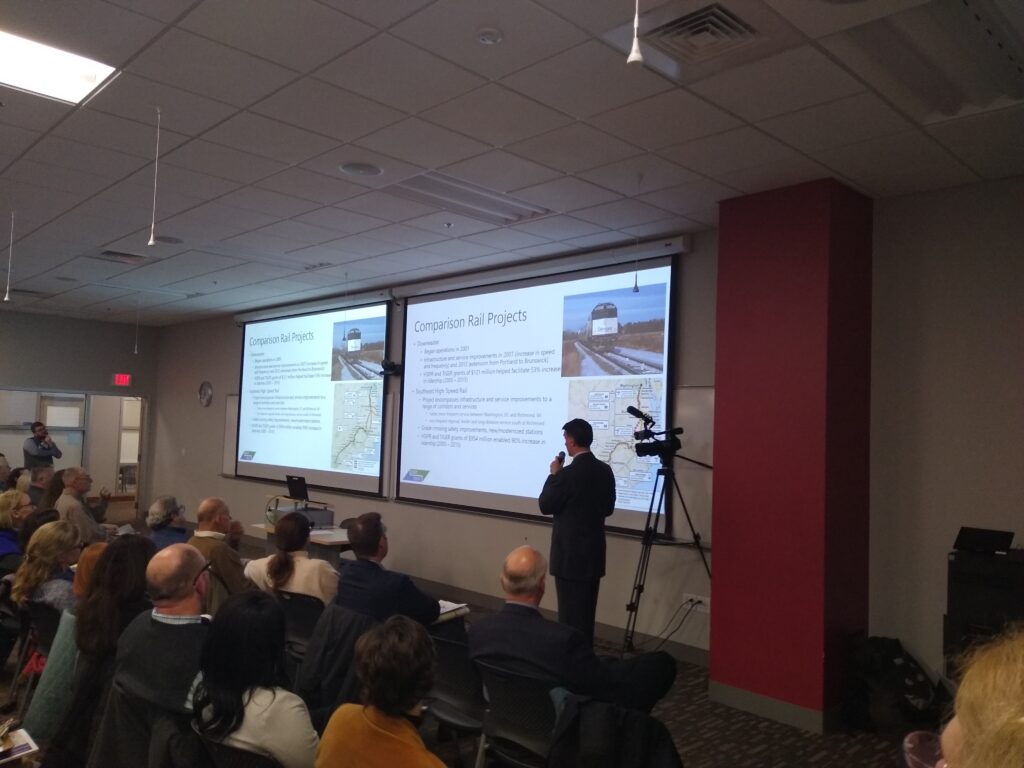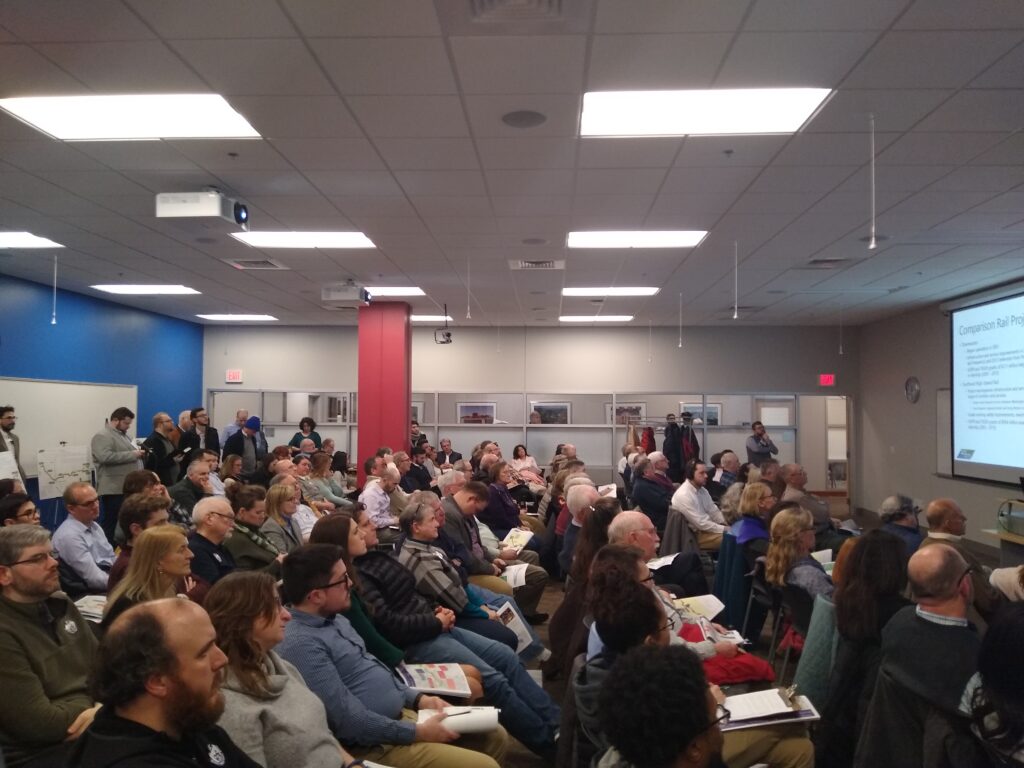Running Low Ridership Figures out of Town on a Rail…
UPDATED 2/13/20 8:33AM: To identify one of the speakers based on another media report.
SPRINGFIELD—On Wednesday night, supporters of added rail service between Western and Eastern Massachusetts packed a room at the UMass Center in downtown for the Massachusetts Department of Transportation first public hearing since unveiling its initial costs and ridership. Those numbers were greeted with intense skepticism, prompting some suspicion that they were forming a pretext for killing that project. That concern was on display as multiple members of the public pointed out that Governor Charlie Baker only approved the study while running for reelection.
At the same time, MassDOT officials were fairly blunt about how their two and low three-figure daily ridership estimates were reached. Projections were based on similar projects like the Hartford Line, the service the State of Connecticut opened between Springfield and New Haven. The calculations did not assume a very high percentage of riders would be daily commuters and induced demand, or ridership the service actually created, was not considered.
Right now, only Amtrak has rail service from here to Boston. The Lake Shore Limited, a train to Chicago, stops in Pittsfield and Springfield on its way to the Hub.
Currently, MassDOT is studying six proposals to establish rail service between Pittsfield and Boston. There is a no-build option, but officials did not seem too keen on it.
The most ambitious, with a $25 billion cost, would build a new set of tracks roughly on or along the Massachusetts Turnpike. The others includes some variation of new track and/or restoration of the second track between Springfield and Worcester, to maneuver around freight trains that CSX still uses. The freight railroad owns the line from west of Worcester.
One option triggered a particular bit of pushback. The cheapest alternate, a rail service between Springfield and Worcester, where riders could transfer to the MBTA’s commuter rail to Boston, included a bus connection to Pittsfield. That had about a $2-3 billion price tag. A phalanx of Berkshire County residents roundly panned that option.
North Adams Mayor Tom Bernard called the bus option to Pittsfield a “nonstarter.”

Sen. Lesser and his colleagues have been trying to stitch a commonwealth together. (created via wikipedia & Lesser campaign images)
The rail study heaved to life about a year ago after Baker capitulated to Senator Eric Lesser, the top legislative proponent of expanded rail service from the 413 to Boston. Baker had resisted the study, going so far as to veto it the year before. The study failed to make its way into the legislature’s final budget, despite passing the Senate, on several occasions since Lesser took office in 2015.
Most and perhaps all of the MassDOT officials on hand were bureaucrats and not political appointees. Still, several speakers called out Baker for vetoing the study and raising money for reelection at the Student Prince, a Springfield restaurant now co-owned by motor coach mogul Peter Picknelly.
One speaker, whom NEPR identified as John Garrett of Greenfield, called the release of these ridership figures a “sandbagging,” pointing to Baker’s campaign cash grab not long after his veto. Baker has raised money several times at the Student Prince.
Another speaker pointed out the political timing, and worried about rising cynicism around the project. The least expensive option—the one with a bus to Pittsfield—showing less than a 100 riders a day with only four or five times as many for the more ambitious proposals. Now that Baker has been reelected, she suggested the numbers telegraphed diminished interest or seriousness from the state.
“Now, here we are, and we are looking at figures that don’t seem realistic in terms of cost, ridership figures that don’t seem realistic in terms of numbers,” she said.
Jay Flynn, a representative of TransitMatters, a pro-transit organization, said the state had a habit of boosting costs to kill projects the governor disfavored. However, he added that rail can transform communities. He pointed the boom in downtown Worcester, following the growth in service between Woo-town and Boston.
Streetsblog Mass has challenged the numbers and officials have publicly questioned the findings. US Representative Richard Neal, the chair of the House Ways & Means Committee, sent a staffer to read a statement, assuring that he was watching what MassDOT did on the project. MassMutual CEO Roger Crandall, also chimed in to back the project.
Officials had been ready for these concerns, at least with regards to ridership. They suggested that the failure to consider reduced demand could change.
Not all comments doubted MassDOT’s intention, but rather focused on maximizing the benefits to the region. Several speakers advocated for the state to pursue a new line that could bring travel times to Boston from Springfield to 80 minutes. Many others backed the more practical options that would use the current CSX line. Those would probably see a relatively quicker start of service.

Chester, the once & future rail hub? (via wikipedia)
Another concern was where stations could go. Some options dropped a station in Palmer. Residents from that community urged MassDOT to not leave their community behind. Palmer was not the only place that did not want to be forgotten. If rail is expanded to Pittsfield, Chester, a Hilltown with its own history of rail as one person noted, could see service restored.
Other attendees urged MassDOT to consider other factors when weighing rail. Among them were the environmental impact service would have by reducing car trips as well as the reduced cost and stress it could provide to those already commuting to the Boston area from the 413.
A few Boston area residents with ties to the Greater Springfield area even made the trip out here, noting the lower cost of housing here. Others had relocated from Boston, but still had jobs out East or had to make several trips out that way.
Officials noted that some factors like timeline for construction and other impacts would not be known until after the study’s next phase. During that period, the recommendations will be narrowed to three.
There were references to Beacon Hill throughout the meeting and the responsibility it would have any project. While Lesser and his colleagues have been following the process closely, the legislature as a whole has been somewhat aloof from the subject. It may ultimately decide what becomes of the project—as a technical matter, it could order the governor to pursue the project if he demurs.
Lucas McDiarmid from the office Spencer State Senator Anne Gobi—whose district includes Palmer—also urged that town’s station be included the final recommendations. He, too, called the numbers into question, given the need, interest and potential of the project.
“We are committed to raising equity for all Western Mass citizens,” he said.

